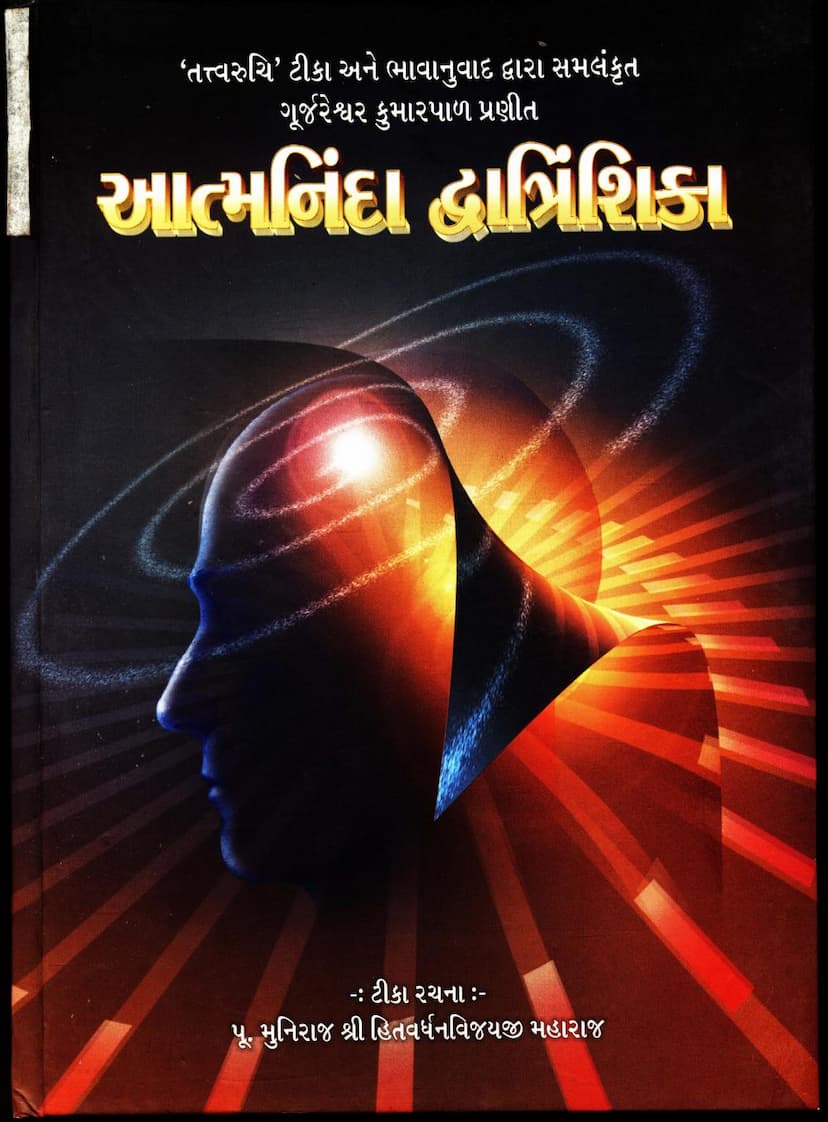Aatmninda Dwatrinshika
Added to library: September 1, 2025

Summary
This document is a publication of the Jain text Aatmninda Dwatrinshika (आत्मनिंदाद्वात्रिंशिका) authored by King Kumarpal (गूर्जरेश्वर, राजवी कुमारपाल). The text is presented with a commentary and interpretive translation called Tattvaruchi (तत्वरुचि), composed by Muni Shri Hitvardhanvijayji Maharaj (मुनिराज श्री हितवर्धनविजयजी महाराज).
Here's a comprehensive summary based on the provided pages:
Book Title: Aatmninda Dwatrinshika (आत्मनिंदाद्वात्रिंशिका) Author: King Kumarpal (गूर्जरेश्वर, राजवी कुमारपाल) Commentary (Tattvaruchi): Muni Shri Hitvardhanvijayji Maharaj (पू. मुनिराज श्री हितवर्धनविजयजी म.) Publisher: Shri Navkar Aradhana Bhavan, Halol Jain Sangh (श्री नवकार आराधना भवन, हालोल जैन संघ)
Key Information and Themes:
- The Aatmninda Dwatrinshika: The original text consists of 32 verses, plus one introductory verse (प्रशस्ति), totaling 33 verses. It is composed in Sanskrit poetry.
- Content: The core theme of the text is the description of the virtues of the Vitaraga (Jinas) and the condemnation (ninda) of the soul's own shortcomings and faults.
- Author's Background: King Kumarpal, the author, was a prominent ruler of Gujarat during the 12th century Vikram era. He was a disciple of the renowned Kalikalsarvajna Shri Hemchandrasuri Maharaj. His spiritual journey led him to embrace Jainism, and his devotion to the Tirthankaras is highly praised. His adherence to the Jin's teachings is described as profound, even leading to the earning of "Ganadhar" karmic potential.
- The Commentary (Tattvaruchi): The Tattvaruchi commentary is written in Sanskrit prose and is described as the first commentary of its kind on the Aatmninda Dwatrinshika, composed approximately 900 years after the original text. The commentary provides the original verses, their grammatical breakdown (anvay), word meanings (shabdarth), verse explanations (shlokarth), and the essence of the commentary (bhavartha). This comprehensive approach makes the text accessible to students of Sanskrit and lay followers alike.
- Purpose of the Publication: The publication by Navkar Aradhana Bhavan aims to spread the knowledge and spiritual essence of this important Jain work, enabling readers to purify their souls through devotion to the Tirthankaras.
- Key Concepts Discussed in the Verses (as indicated by the commentary excerpts):
- Praise of Jinas (Jineshvara/Jineendra): The verses begin with extolling the virtues and auspicious qualities of the Jinas, including their victory over internal enemies (kashayas), their role as guides, and their divine attributes (atishayas).
- Self-Condemnation (Aatmninda): The author expresses his own limitations, ignorance, and the struggle against internal enemies like passions (moha, kama, krodha). He acknowledges his failings and seeks divine grace.
- Devotion and Surrender: The text emphasizes surrender to the Jinas, recognizing them as the sole refuge and the source of liberation. Devotion is presented as the means to overcome obstacles and achieve spiritual progress.
- The Power of Jain Teachings: The verses highlight the efficacy of following the teachings of the Jinas, which lead to the destruction of past karma and the attainment of spiritual bliss.
- The Nature of the Soul and Karma: The commentary delves into the workings of karma, the impact of passions, and the struggle for self-purification. It explains how actions, intentions, and the influence of past karma shape one's spiritual journey.
- The Goal of Liberation (Moksha): The ultimate aim is to achieve liberation from the cycle of birth and death, a state of pure consciousness and eternal bliss, which is attainable through devotion to the Jinas and adherence to their teachings.
- The Role of the Guru: The importance of learned and virtuous gurus, like Shri Hemchandrasuri, is acknowledged as crucial for understanding and practicing the Jain path.
- Distinguishing True Devotion: The text differentiates between genuine devotion to the Jinas and the futile worship of other deities (kutirthikas) who cannot grant liberation.
- Spiritual Stages and Practices: The commentary touches upon various stages of spiritual development and practices, such as meditation, detachment, ethical conduct, and the cultivation of virtues.
- Metaphors Used: The text employs rich metaphors to convey spiritual truths, such as the Jina as a guide through the ocean of samsara, the soul as a vessel seeking refuge, and passions as thieves.
Overall Message:
The Aatmninda Dwatrinshika, through King Kumarpal's verses and Muni Shri Hitvardhanvijayji's commentary, serves as a powerful reminder of the soul's own imperfections and the supreme importance of devotion to the Tirthankaras. It encourages introspection, self-condemnation of faults, and unwavering surrender to the path shown by the Jinas to achieve ultimate liberation. The publication aims to make these profound spiritual insights accessible to a wider audience.